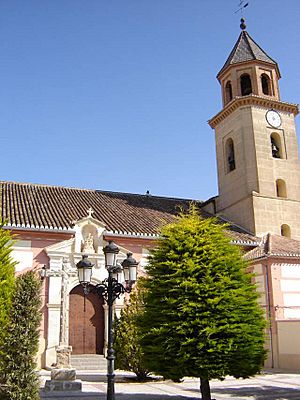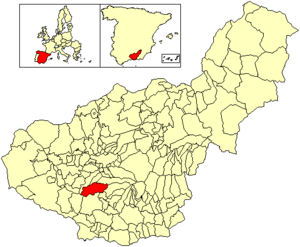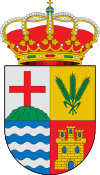El Padul facts for kids
Quick facts for kids
El Padul
|
||
|---|---|---|
| Padul | ||

Parish church of the Virgin Mary
|
||
|
||

Location of El Padul
|
||
| Country | ||
| Autonomous community | ||
| Province | Granada | |
| Comarca | Valle de Lecrín | |
| Judicial district | Granada | |
| Area | ||
| • Total | 89 km2 (34 sq mi) | |
| Elevation | 744 m (2,441 ft) | |
| Population
(2018)
|
||
| • Total | 8,396 | |
| • Density | 94.3/km2 (244.3/sq mi) | |
| Demonym(s) | Paduleño, -ña. | |
| Time zone | UTC+1 (CET) | |
| • Summer (DST) | UTC+2 (CEST) | |
| Postal code |
18640
|
|
El Padul is a small town in south-eastern Spain. It is located in the province of Granada. This town is part of the Valle de Lecrín area. In 2008, about 8,440 people lived there. El Padul is about 13 kilometers (8 miles) south of the city of Granada. It sits 744 meters (2,441 feet) above sea level.
Contents
Geography
Where is El Padul?
El Padul shares its borders with several other towns. To the north, it borders Alhendín, Otura, and Dílar. To the east, you'll find Dúrcal and Villamena. To the south, it borders Las Albuñuelas. Finally, to the west, it borders Jayena.
Amazing Nature: El Padul's Wetland
One of the most special places in El Padul is its wetland. This area is very important for nature in south-eastern Spain. It has even been added to the Ramsar Convention. This is a list of wetlands that are important around the world.
The wetland has the biggest peatland in the Mediterranean basin. A peatland is a type of wetland where dead plants build up over thousands of years. This creates a special soil called peat. Many rare and endangered animals and plants live here.
History
What's in a Name?
The name El Padul comes from the ancient Roman era. It comes from the Latin word paludem, which means wetland or bog. This name clearly refers to the big wetland nearby.
For many centuries, we don't have many old writings about the town's name. So, we don't know exactly how the Latin word changed over time. We also don't know when the word "El" was added. "El" is a definite article (like "the" in English). It might have come from the Latin word ille. Or, it could have come later from the Arabic word al.
During the time of the Nasrid dynasty, a writer named Ibn al-Khatib wrote the name as "Al-Badul". He used "B" because the "P" sound doesn't exist in Arabic. But people probably still said "P".
The modern name, El Padul, first appeared in Spanish writings in the 1500s. For example, a book from 1571 mentions "El Padul".
The Name Debate
In the 1900s, many road signs just said "Padul" without "El". This caused a lot of debate about the town's true name.
Near the end of the 20th century, some writers and history teachers in the town wanted to officially bring back the full name. On December 18, 2000, the Town Council agreed. They all voted to make El Padul the official name of the town.
Ancient Discoveries
Many ancient things have been found in El Padul. These finds show that people and animals lived here a very long time ago.
In 1982, scientists found fossilized remains of mammoths near the wetland. These huge, elephant-like animals lived here during the Middle Pleistocene period. You can see a mammoth tusk from El Padul at the Sciences Park in Granada.
The oldest signs of humans are from the Middle Paleolithic age. Tools like projectile points and racloirs were found. These suggest that Neanderthals lived near the wetland and in nearby caves.
Later, many Neolithic remains were found. These include pottery, bracelets, and tools for farming and daily life.
Culture
Important Buildings
- Casa Grande (1500s): This is a large, old palace. It was even used as a filming location for the movie The Long Duel.
- Church of Santa María la Mayor (1500s - 1700s): This beautiful church is a main landmark.
- Chapel of Saint Sebastian (1700s): A smaller, historic religious building.
- Source of the Five Pipes (Lavadero) (1500s - 1800s): This was a public washing place with five water spouts.
- Roman Road: You can still see parts of an old Roman road. This road once connected the ancient cities of Ilíberis (Granada) and Sexi (Almuñécar). It is found in an area called Los Molinos.
Fun Festivals
El Padul has many lively festivals throughout the year.
- Saint Sebastian's Day (January 19-20): On the afternoon of January 19, people go to the mountains to gather firewood and sweet-smelling plants. They then make big bonfires, called pyres, during a parade for Saint Sebastian. The next day, January 20, there's another parade with more huge bonfires and even gunshots! People sing a special song for Saint Sebastian on these days.
- Carnival: This is a fun time when many people dress up in costumes. They sing funny and playful songs that often make fun of things.
- Holy Week: During Holy Week, the "Jesus Christ's Burial" parade on Good Friday is very important. This parade tells the story of the Passion (the last days of Jesus's life) using 10 pasos. Pasos are large, moving sculptures carried through the streets.
- The Fair: The town's main fair is held on the last weekend of September. It's a time for celebration and fun.
- Food, Agriculture and Tourism Fair (December 6-8): This fair celebrates local food, farming, and tourism. At the same time, they also celebrate "wine day" and "pig slaughter day," which are traditional events.
See also
 In Spanish: Padul para niños
In Spanish: Padul para niños



